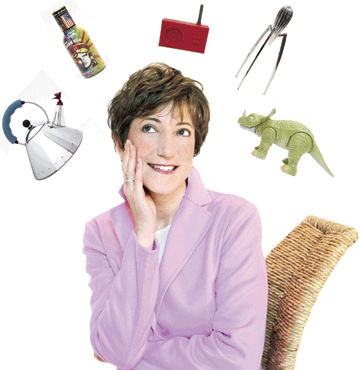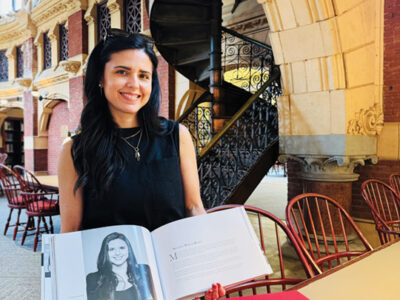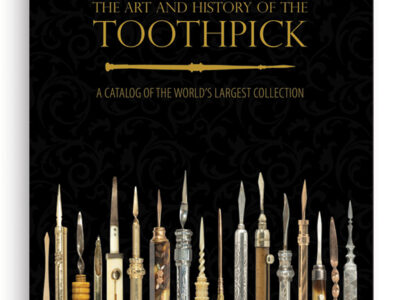
Lisa Roberts CW’74 is sitting in her home office in downtown Center City Philadelphia, perched in a white Air-Chair, her head framed by a spinning Flower Power fan with soft-plastic blades colored the same blue as Marge Simpson’s hair. At the stroke of 11, a sheep breaks through its faux-wooden barn door in a cuckoo clock and begins to bleat.
Through a window opposite where Roberts is sitting, a construction crew works on the house that she, her husband (David Seltzer WG’76), and their two sons hope to move into this spring—behind its 1810 façade, the townhouse was gutted. Roberts told the architect, “I want you to design a house that we didn’t know existed.”
It took a while for Roberts to become so comfortable with design that’s a little bit different. When she was growing up, her family’s house was unlike her friends’. Designed by a student of Frank Lloyd Wright, it was an off-center A-frame built into a hillside, in a Philadelphia suburb that was full of standard suburban homes.
“It was so attention-getting,” she says. “I was mortified. I was afraid people knew me for my house more than for anything else.”
Today it’s her self-appointed mission to spread the gospel of innovative design. Her vehicle is Antiques of the Future, a collection of around 350 objects she started buying in the mid-1980s. Her website, www.antiquesofthefuture.com, is a virtual museum that makes the collection searchable by designer, manufacturer, or product. In the last two years, she’s appeared on two TV shows, Smart Design and Ultimate Collector. She hopes to continue the momentum with her own TV show some day, and maybe a regular magazine column. Having recently signed a deal with the publisher Stewart, Tabori and Chang, Roberts is finishing work on a book featuring 75 pieces from her collection. It’ll hit stores next fall. “The idea,” she says, “is to create a brand.”
Roberts came by this venture circuitously, changing careers from architect to product-designer when she was in her early thirties. After graduating from Washington University with a master’s degree in architecture, she worked for six years in firms in Boston and Philadelphia before moving into the design business, first as a licensing agent for an artist friend and then with her own firm, Lisa S. Roberts Design. Perched on desks and bookcases around her office are some of the products she’s helped create: baseballs sporting artists’ signatures, a boxy paper clock that looks like the Philadelphia Museum of Art, drinking glasses adorned with bold colors and shapes.
“I can’t really draw,” she says. “I’m not artistically particularly talented. But I’ve always been great with a pair of scissors.” Most of her designs are cut-paper creations that have been reproduced on everything from gift-wrap to mouse pads.
“Recognize this?” She bends to open one of the flat files where she keeps her cut-paper originals, pulls out a piece of foam core, and lifts the sheet of protective paper. A collection of tiny bits and larger pieces of Pantone paper combine to depict the interior of Irvine Auditorium in colors that twang and vibrate. The image was a Christmas card for former Penn President Judith Rodin CW’66 Hon’04 and her family.
Roberts’ transition from architect to product-designer happened right when architects were starting to turn their attention from buildings to bath accessories. As a designer shopping her portfolio to manufacturers at trade shows, she was well placed to track the trend of high-design merging with household products.
“I saw who was being highlighted in manufacturers’ booths,” she says. “I was reading the trade journals. I knew who was getting press.”
Among her first acquisitions was Zolo, a reinvented Mr. Potato Head. Other “future classics” in her collection range from the whistle-spout teakettle designed by Michael Graves (and sold at Target) to a knotted chair designed by Marcel Wanders and in the permanent collections of at least three major museums.
“Suddenly industrial design starting having this sexiness to it,” she recalls. “It wasn’t just functional anymore—it began to have these funky elements.”
At the beginning, she collected what she liked. Now she consults with museum curators and design professionals before she adds a piece.
Her role as design advocate extends to her commitments to the Philadelphia Museum of Art—where she’s a trustee and member of Collab, a nonprofit group of design professionals dedicated to supporting the museum’s collections of modern and contemporary design—and to the Charter School for Architecture and Design in Philadelphia, where she’s an honorary trustee. She founded Collab’s annual college-level student-design competition that just celebrated its 13th year, bringing high-profile designers like Karim Rashid and Philippe Starck to the museum for exhibitions and allowing design students in and around Philadelphia to tackle such design challenges as shopping bags, watches, and CD covers.
One of these students’ names may some day make it into Antiques of the Future, but Roberts doesn’t expect that hers ever will. “I’m not a great designer,” she says, “but I understand what makes for great design.”
–Caroline Tiger C’96




